Permaculture companion plants for Pea
| Image | Name | Data | Description | Actions |
|---|---|---|---|---|
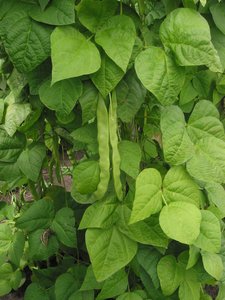
|
Common bean |
2-11
Annual
Full sun
Moist
Light (sandy), Medium, Heavy (clay)
2.0
Vines
Biomass, Dye, antifungal, Nitrogen fixer
true
Leaves, Seed, Seedpod
Seed - transplant, Seed - direct sow
https://en.wikipedia.org/wiki/Phaseolus_vulgaris
Pole bean, Climbing bean, French bean, Bush bean, Dwarf bean, Kidney bean, Green bean
Fabaceae, Leguminosae
Stangenbohne
https://pfaf.org/User/Plant.aspx?LatinName=Phaseolus vulgaris
16-18°c (70-80°f)
6.0-6.8
2.5 cm
16cm
4-10 days
45-85
Fast
Sperzieboon
Costa Rica, Guatemala, Honduras, Mexico Central, Mexico Gulf, Mexico Northeast, Mexico Northwest, Mexico Southeast, Mexico Southwest, Nicaragua, Panamá
Altay, Amur, Andaman Is., Angola, Argentina Northeast, Argentina Northwest, Assam, Baltic States, Bangladesh, Belarus, Bolivia, Bulgaria, Buryatiya, Cameroon, Cayman Is., Central European Rus, Chad, Chita, Colombia, Comoros, Cuba, Czechoslovakia, Dominican Republic, East European Russia, East Himalaya, Ecuador, Ethiopia, Guinea, Gulf of Guinea Is., Haiti, Illinois, India, Iraq, Irkutsk, Jamaica, Jawa, Kazakhstan, Kenya, Khabarovsk, Kirgizstan, Korea, Krasnoyarsk, Kuril Is., Leeward Is., Malaya, Marianas, Maryland, Mongolia, Myanmar, Nepal, New Guinea, New York, Nicobar Is., Nigeria, North Caucasus, North European Russi, Northwest European R, Pakistan, Peru, Philippines, Primorye, Puerto Rico, Queensland, Rwanda, Sakhalin, Senegal, South European Russi, Sri Lanka, Tadzhikistan, Tanzania, Thailand, Togo, Transcaucasus, Trinidad-Tobago, Turkmenistan, Tuva, Uganda, Ukraine, Uzbekistan, Venezuela, Vietnam, Wake I., West Himalaya, West Siberia, Yakutskiya, Zambia, Zaïre
2-4 weeks before last frost
1 week after last frost, 12-14 weeks before first frost
3-5 years
0.4
https://powo.science.kew.org/taxon/urn:lsid:ipni.org:names:514191-1
Coffee, Condiment
|
This entry describes all varieties of the common bean. This includes vining and bush/darf variaties and can have different names depending on their style of growths (see alternate names). These include the kidney bean, the navy bean, the pinto bean, the French bean and the wax bean The common bean, scientific name Phaseolus vulgaris, is a herbaceous annual plant native to the Americas, specifically the regions extending from the southwestern United States to South America. It is a member of the Fabaceae (legume) family. The common bean has a range of different appearances, depending on the variety. Most varieties have a simple, erect stem that grows to a height of 20-60 cm. The leaves are typically green and consist of 3-5 oblong leaflets. The flowers are small and white, pink, or purple in color. The fruit is a legume, which contains the seeds. The common bean is typically a small plant, but some varieties can grow to be quite large, reaching heights of up to 2 meters. The plant grows relatively quickly, with the growing season typically lasting between 60-100 days. The common bean prefers well-drained soil and full sun, but can also grow in partial shade. It is sensitive to frost and should be planted after the last frost date in the spring. To cultivate the common bean successfully, a grower may need to ensure that the soil is adequately fertilized and provide support for the plant to climb, if necessary. The common bean is edible, with the seeds and the young pods being the most commonly consumed parts. The seeds can be cooked and eaten as a protein-rich vegetable, and the young pods can be eaten as a green vegetable. The edible parts can be stored after harvest by drying the seeds or by preserving the young pods in vinegar or oil. The common bean has many uses beyond being a food source. The plant can fix nitrogen in the soil, improving its fertility and making it a useful companion plant for other crops. The dried leaves and stems of the common bean can be used as mulch or as a source of organic matter. In some cultures, the fibers from the stems are used to make ropes or other weaving materials. Additionally, the plant has been used medicinally to treat a variety of ailments. The common bean is also valuable for wildlife. The flowers attract bees and other pollinators, and the plant provides food for a variety of insects, birds, and small mammals. ### Links [Beans Seed Starting Tips @ Harvest to Table](https://harvesttotable.com/beans-seed-starting-tips/) ### Propagation - direct sow Direct-sow beans in spring after all danger of frost has passed and soil is at least 16°C (60°F). In warm-winter regions, sow beans in late summer for harvest in winter. Time sowing so that beans come to harvest before the first frost. |
Show
Edit |
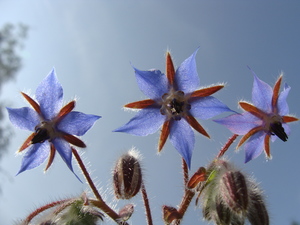
|
Borage |
6-9
Annual
Full sun, Partial sun/shade
Dry, Moist
Light (sandy), Medium, Heavy (clay)
0.6
Herbs
Flowers, Leaves
Seed - direct sow
https://en.wikipedia.org/wiki/Borage
Medium
Common borage, Cool-tankard, Tailwort, Starflower
Boraginaceae
Borretsch
60cm
5-15 days
21°c (70°f)
Oil, Colouring, Tea
https://pfaf.org/User/Plant.aspx?LatinName=Borago officinalis
Borago
5
-2
Algeria, Baleares, Corse, France, Greece, Italy, Kriti, Libya, Morocco, Portugal, Sardegna, Sicilia, Spain, Tunisia, Yugoslavia
Alaska, Alberta, Altay, Argentina Northeast, Argentina Northwest, Argentina South, Austria, Azores, Baltic States, Belgium, Bolivia, British Columbia, Buryatiya, California, Canary Is., Central European Rus, Chile Central, Colombia, Connecticut, Cuba, Cyprus, Czechoslovakia, District of Columbia, Dominican Republic, East Aegean Is., East European Russia, Ecuador, Germany, Great Britain, Guatemala, Haiti, Honduras, Hungary, Illinois, Irkutsk, Jawa, Kamchatka, Kazakhstan, Kirgizstan, Krym, Kuril Is., Lebanon-Syria, Madeira, Maine, Manitoba, Massachusetts, Mexico Central, Mexico Southwest, Michigan, Minnesota, Montana, Netherlands, New Brunswick, New Hampshire, New Jersey, New York, New Zealand North, New Zealand South, Newfoundland, North Caucasus, North Dakota, North European Russi, Northwest European R, Nova Scotia, Ohio, Ontario, Oregon, Pennsylvania, Peru, Poland, Primorye, Prince Edward I., Puerto Rico, Québec, Rhode I., Romania, Sakhalin, Saskatchewan, South European Russi, Switzerland, Tasmania, Tubuai Is., Turkey, Turkey-in-Europe, Turkmenistan, Ukraine, Uruguay, Utah, Vermont, Virginia, Washington, West Siberia, West Virginia, Wisconsin
At last frost
0.3
https://powo.science.kew.org/taxon/urn:lsid:ipni.org:names:113618-1
Dye, oil, Dynamic accumulator
true
|
Borage, also known as Borago officinalis, is a herb native to the Mediterranean region. It is a hairy, annual herb that grows to a height of about 60 cm, with blue, star-shaped flowers and large hairy leaves. The plant is easily differentiated from similar plants by its hairy stems and leaves, and its bright blue flowers. Borage prefers well-drained soil and full sun, and grows best in warm temperatures. It is a fast-growing plant, and can be easily cultivated by direct sowing or transplanting seedlings. Borage is not winter hardy, and should be grown as an annual in most climates. The leaves and flowers of borage are edible, and can be used in salads, soups, and other dishes. The leaves have a cucumber-like flavor, while the flowers are slightly sweet. The edible parts of the plant can be stored by freezing or drying. Borage has several medicinal uses, and has been used traditionally to treat a variety of ailments, including respiratory problems, skin irritation, and anxiety. It is also a good source of nutrients, including calcium, potassium, and vitamin C. In addition to its medicinal uses, borage has value as a companion plant in the garden. It attracts pollinators, such as bees and butterflies, and can be used as a natural pest deterrent. #### Propagation Direct sow early spring when temperatures reach 21°C (70°F). Best sown directly, as borage develops a delicate taproot. #### Links [Borage @ West Coast Seeds](https://www.westcoastseeds.com/products/borage) |
Show
Edit |

|
Carrot |
3-10
Biennial
Full sun
Moist
Light (sandy), Medium, Heavy (clay)
1.2
Leaves, Root
Apiaceae or Umbelliferae
Möhre, Karotte
https://pfaf.org/User/Plant.aspx?LatinName=Daucus carota sativus
Afghanistan, Albania, Algeria, Austria, Azores, Baleares, Baltic States, Belarus, Belgium, Bulgaria, Canary Is., Cape Verde, Central European Rus, China South-Central, China Southeast, Corse, Cyprus, Czechoslovakia, Denmark, East Aegean Is., East European Russia, Eritrea, Ethiopia, France, Germany, Great Britain, Greece, Hungary, Iran, Iraq, Ireland, Italy, Kazakhstan, Kirgizstan, Kriti, Krym, Lebanon-Syria, Libya, Madeira, Morocco, Nepal, Netherlands, North Caucasus, Northwest European R, Norway, Pakistan, Palestine, Poland, Portugal, Romania, Sardegna, Sicilia, South European Russi, Spain, Sweden, Switzerland, Tadzhikistan, Transcaucasus, Tunisia, Turkey, Turkey-in-Europe, Turkmenistan, Ukraine, Uzbekistan, West Himalaya, Yugoslavia
Alabama, Amsterdam-St.Paul Is, Andaman Is., Angola, Argentina Northeast, Argentina Northwest, Argentina South, Arizona, Arkansas, Bangladesh, Brazil South, British Columbia, California, Cape Provinces, Chile Central, Chile South, China North-Central, Colorado, Connecticut, Costa Rica, Cuba, Delaware, Desventurados Is., District of Columbia, Dominican Republic, Easter Is., Ecuador, El Salvador, Finland, Florida, Georgia, Guatemala, Hainan, Haiti, Iceland, Idaho, Illinois, India, Indiana, Inner Mongolia, Iowa, Jamaica, Japan, Jawa, Kansas, Kentucky, Kermadec Is., Korea, Labrador, Leeward Is., Louisiana, Maine, Manchuria, Manitoba, Marianas, Marshall Is., Maryland, Massachusetts, Mauritius, Mexico Central, Mexico Northeast, Michigan, Minnesota, Mississippi, Missouri, Mongolia, Montana, Myanmar, Nebraska, Nevada, New Brunswick, New Hampshire, New Jersey, New Mexico, New York, New Zealand North, New Zealand South, Newfoundland, Nicobar Is., North Carolina, North Dakota, North European Russi, Northern Provinces, Nova Scotia, Ohio, Oklahoma, Ontario, Oregon, Pennsylvania, Peru, Primorye, Prince Edward I., Puerto Rico, Qinghai, Québec, Rhode I., Rodrigues, Réunion, Saskatchewan, South Carolina, South Dakota, Sri Lanka, Sudan, Tasmania, Tennessee, Texas, Tibet, Trinidad-Tobago, Uruguay, Utah, Vermont, Vietnam, Virginia, Washington, West Siberia, West Virginia, Wisconsin, Wyoming, Xinjiang
0.20
https://powo.science.kew.org/taxon/urn:lsid:ipni.org:names:841063-1
Coffee, Colouring, Condiment
Alcohol, Dye, Essential Oil, Dynamic accumulator, Fragrance
true
|
Carrot (Daucus carota sativus) is a type of root vegetable that is native to Europe and Asia. It belongs to the family Apiaceae, which includes around 300 species of plants. Carrots are a popular crop, known for their sweet, crunchy roots and vibrant orange color. The plant has a tall, slender growth habit and can reach a height of up to 2-3 feet. The leaves are green and feathery, and the flowers are small and white or purple in color. To grow carrots successfully, it is important to choose a location with well-drained, sandy soil and full sun. The plant prefers cool temperatures and should be protected from frost. Carrots can also be grown in containers, and will benefit from regular watering and fertilization. The plant is relatively easy to grow and requires little maintenance, but can be susceptible to pests and diseases, such as carrot fly and root rot. Carrots are a valuable source of vitamins and minerals, and are used in a variety of dishes, including soups, stews, and salads. The roots can be eaten fresh or cooked, and can be stored in the refrigerator for several weeks. In addition to their culinary uses, carrots have a number of medicinal properties, and have been used to treat a variety of ailments, including indigestion, constipation, and respiratory disorders. Carrots are also a valuable food source for many types of wildlife, including birds, insects, and small mammals. The flowers attract bees and other pollinators, and the roots are eaten by animals such as rabbits and deer. |
Show
Edit |
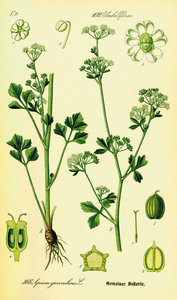
|
Celery |
5-9
Partial sun/shade
Moist
Light (sandy), Medium, Heavy (clay)
0.6
0.5
Annual, Biennial
Herbs
true
Leaves, Root, Seed
Ajwain-ka-patta (indian)
Sellerie
Apiaceae or umbelliferae
Argentina Northeast, Bolivia, Brazil South, Brazil Southeast, Paraguay, Uruguay
https://en.wikipedia.org/wiki/Celery
https://pfaf.org/User/Plant.aspx?LatinName=Apium graveolens
https://powo.science.kew.org/taxon/urn:lsid:ipni.org:names:16467-2
Condiment
Essential Oil, Fragrance
|
Show
Edit |
|

|
Zea mays |
2-11
Full sun
Moist
Light (sandy), Medium, Heavy (clay)
2
0.66
Annual
Fast
true
Pollen, Seed, Stem
Oil, Coffee
Maize, corn, abado, able, aburow, agbado, awasi, awi, bara-jowar, bhutta, blefo, bli, buta, chujak, goinjol, gomdhan, igbado, jagung, janar, jonar, junri, kaaba, keto, kolkoti, kon, kono, kukri, maka, makai, makka jonnalu, makka-cholam, makka, makkai, makkari, makoi, masara agwado, massara, mekkejola, milho, mokka-janna, musukojola, naham, nyo, oka, oksusu, shaa, sil ni vavalagi, ta-mank, yu shu shu, ai, amylum maydis, awási, aya, corn oi, 6 corn oil (unhydrogenated), corn silk, corn starch, corn syrup solids, corn|iringu, dent corn, dura shami, field corn, flint corn, gangnaengi, granoturco, indian corn, maidis stigma, mais, maiz, aceite, maize oil, refined, maize starch, majs, maydis amylum, maydis oleum raffinatum, maydis stigma, maíz, aceite refinado, maîs, maïs, ogsusu, oleum maydis, pelos de elafe, pod corn, popcorn, refined maize oil, risoy genime sami, stigmata maidis, styli cum stigmatis zeae maydis, sweet corn, topical starch, to-morokoshi, yu mi shu, yu mi xu, zein, zorrat
Mais
Poaceae or gramineae
Guatemala, Mexico Central, Mexico Southwest
Afghanistan, Alabama, Albania, Aldabra, Algeria, Amur, Andaman Is., Angola, Argentina Northeast, Arizona, Arkansas, Aruba, Assam, Austria, Azores, Bahamas, Baleares, Baltic States, Bangladesh, Belarus, Belgium, Belize, Benin, Bismarck Archipelago, Bolivia, Borneo, Brazil North, Brazil Northeast, Brazil South, Brazil Southeast, Brazil West-Central, Bulgaria, Burkina, Burundi, California, Cambodia, Cameroon, Canary Is., Caroline Is., Cayman Is., Central African Repu, Central European Rus, Chad, Chagos Archipelago, China North-Central, China South-Central, China Southeast, Christmas I., Colombia, Colorado, Comoros, Connecticut, Corse, Costa Rica, Cuba, Cyprus, Czechoslovakia, Djibouti, Dominican Republic, East European Russia, East Himalaya, Ecuador, Egypt, Equatorial Guinea, Ethiopia, Fiji, Florida, France, French Guiana, Galápagos, Gambia, Georgia, Germany, Ghana, Great Britain, Greece, Guinea, Guinea-Bissau, Gulf of Guinea Is., Hainan, Haiti, Hawaii, Honduras, Hungary, Idaho, Illinois, India, Indiana, Iowa, Iraq, Ireland, Italy, Ivory Coast, Jamaica, Japan, Jawa, Kansas, Kazakhstan, Kentucky, Khabarovsk, Kirgizstan, Korea, Kriti, Krym, Laos, Leeward Is., Lesser Sunda Is., Louisiana, Madagascar, Maine, Malaya, Mali, Maluku, Manchuria, Marianas, Marshall Is., Maryland, Massachusetts, Mauritius, Mexico Gulf, Mexico Northeast, Mexico Northwest, Mexico Southeast, Minnesota, Mississippi, Missouri, Montana, Morocco, Mozambique, Myanmar, Nansei-shoto, Nebraska, Nepal, Netherlands, Netherlands Antilles, Nevada, New Caledonia, New Guinea, New Hampshire, New Jersey, New Mexico, New York, Nicaragua, Niger, Nigeria, Niue, North Carolina, North Caucasus, Northwest European R, Ohio, Oman, Ontario, Oregon, Pakistan, Panamá, Pennsylvania, Peru, Philippines, Pitcairn Is., Poland, Portugal, Primorye, Puerto Rico, Queensland, Québec, Rhode I., Rodrigues, Romania, Rwanda, Réunion, Sakhalin, Samoa, Sardegna, Seychelles, Sicilia, Sierra Leone, Somalia, South Carolina, South European Russi, Spain, Sri Lanka, Sudan, Switzerland, Tadzhikistan, Tanzania, Tennessee, Texas, Thailand, Togo, Transcaucasus, Trinidad-Tobago, Tunisia, Turkey, Turkey-in-Europe, Turkmenistan, Ukraine, Uruguay, Utah, Uzbekistan, Vanuatu, Venezuelan Antilles, Vermont, Vietnam, Virginia, Wake I., Washington, West Himalaya, West Virginia, Western Australia, Windward Is., Wisconsin, Wyoming, Yemen, Yugoslavia, Zambia, Zaïre
https://en.wikipedia.org/wiki/Maize
https://pfaf.org/User/Plant.aspx?LatinName=Zea mays
https://powo.science.kew.org/taxon/urn:lsid:ipni.org:names:426810-1
Adhesive, Fire starter, oil, textiles
|
Corn (Zea mays) is a plant native to Central America and Mexico. It is a tall plant with a sturdy stem and large leaves that grow in a spiral pattern around the stem. The plant produces large, brightly colored flowers that give way to ears of corn. The ears are typically yellow, but can also be white, red, or blue. Corn grows to be anywhere from 3-12 feet tall and can grow quickly, depending on the variety. To differentiate corn from similar plants, gardeners and farmers can look for the spiral pattern of the leaves and the presence of ears. Corn is often grown in rows, which can also help to distinguish it from other plants. Corn prefers well-draining, fertile soil and full sun. In order to cultivate it successfully, a grower will need to provide these conditions and also ensure that the plants receive adequate water. Corn is often grown from seed, which should be planted in the ground when the soil has warmed to at least 60 degrees Fahrenheit. Corn is edible, and the edible parts are the kernels that are found on the ears. The ears can be harvested when the kernels are plump and fully developed. They can be stored after harvest by drying them in the sun or by freezing them. Corn has many uses. In addition to being a popular food crop, it can also be used as livestock feed and as a source of biofuel. It can also be used as a building material and for crafting. Corn has medicinal properties and has been used to treat a variety of ailments. It is also valued by wildlife, as it provides food and shelter for birds, small mammals, and insects. |
Show
Edit |
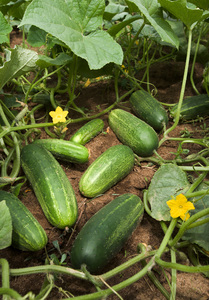
|
Cucumis sativus |
9-11
Annual
Full sun
Moist
Light (sandy), Medium, Heavy (clay)
2
Vines
Fruit, Leaves, Seed
Seed - direct sow, Seed - transplant
1 week after last frost
https://en.wikipedia.org/wiki/Cucumber
Cucurbitaceae
Gurke
50-65
23cm
6.0-6.8
15-30°C (60-85°F)
https://pfaf.org/User/Plant.aspx?LatinName=Cucumis sativus
True
Fruit
Assam, Bangladesh, China South-Central, China Southeast, East Himalaya, Myanmar, Nepal, Thailand, West Himalaya
Alabama, Albania, Andaman Is., Arizona, Arkansas, Austria, Bahamas, Bolivia, Caroline Is., Cayman Is., Colombia, Costa Rica, Cuba, Czechoslovakia, Denmark, Dominican Republic, Ecuador, Florida, Georgia, Gulf of Guinea Is., Haiti, Illinois, India, Jamaica, Kansas, Kazakhstan, Kentucky, Korea, Laos, Leeward Is., Louisiana, Marianas, Marshall Is., Massachusetts, Michigan, Mississippi, Missouri, New Caledonia, New York, Nicaragua, Nicobar Is., North Carolina, North Caucasus, Ohio, Oman, Ontario, Pakistan, Pennsylvania, Pitcairn Is., Puerto Rico, South Carolina, Sri Lanka, Sweden, Tadzhikistan, Trinidad-Tobago, Turkmenistan, Utah, Uzbekistan, Venezuela, Vietnam, Virginia, Windward Is., Zaïre
2-3 weeks before last frost
1 week after last frost
0.9
https://powo.science.kew.org/taxon/urn:lsid:ipni.org:names:292296-1
Oil
Cosmetic, oil
true
|
Cucumber, scientific name Cucumis sativus, is a member of the gourd family. It is native to India and other parts of Asia. Cucumber is a trailing or climbing plant that grows to a height of 5-10 feet. The leaves are dark green and glossy, and the plant produces yellow flowers. The fruit of the cucumber plant is a long, green, edible vegetable with a thin skin. Cucumbers are typically about 6-9 inches long and 2-3 inches in diameter. In terms of growth and cultivation, cucumber plants prefer warm, sunny conditions and well-draining soil. They should be watered regularly, especially during dry periods. Cucumber plants are not winter hardy and should be grown in the summer months in most climates. To cultivate cucumbers successfully, it is important to provide them with adequate space to grow and to support the plants with trellises or other means to keep the fruits off the ground. The plant will develop male and female flowers. You can recognize the female by having a tiny cucumber underneath. Sometimes the plant develops a lot of male flowers first, so be patient. If you don’t see any bees pollinating. Take a male and put it on all the female flowers. Cucumber fruits are edible and can be eaten raw, pickled, or cooked. The skin and seeds of the cucumber are edible, but some people choose to remove the seeds before eating the fruit. Cucumber fruits can be stored in the refrigerator for a few days after harvest. Cucumbers have several uses. In addition to being eaten as a vegetable, they can also be used in a variety of dishes and salads. Cucumber slices are often used as a garnish or as a refreshing addition to beverages. Cucumbers are also commonly used in natural skin care products and are believed to have anti-inflammatory and soothing properties. #### Propagation Direct sow when soil is warm enough in early summer. Sow seeds individually indoors 3-4 weeks before planting outside into warm soil. Use bottom heat if possible. Transplant when plants develop third leaf. #### Medicinal Fruit is depurative, diuretic, emollient, purgative and resolvent #### Links [Cucumber @ West Coast Seeds](https://www.westcoastseeds.com/products/patio-snacker) |
Show
Edit |
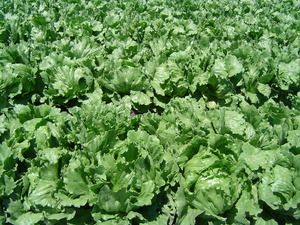
|
Lactuca sativa |
5-9
Annual, Biennial
Full sun, Partial sun/shade
Moist
Light (sandy), Medium
0.9
Herbs
true
Leaves, Seed
https://en.wikipedia.org/wiki/Lettuce
Garden lettuce
Asteraceae or compositae
Blattsalat
Oil
https://pfaf.org/User/Plant.aspx?LatinName=Lactuca sativa
Iraq
Alabama, Antipodean Is., Argentina Northeast, Assam, Austria, Baleares, Baltic States, Bangladesh, Belize, Bolivia, Bulgaria, Burkina, California, Cameroon, Canary Is., Cape Provinces, Cape Verde, Caroline Is., Central European Rus, Chad, China North-Central, Colombia, Connecticut, Corse, Costa Rica, Cuba, Cyprus, Czechoslovakia, Delaware, District of Columbia, Dominican Republic, East European Russia, East Himalaya, Ecuador, Egypt, El Salvador, Fiji, Finland, France, Free State, Germany, Great Britain, Guatemala, Haiti, Hawaii, Honduras, Hungary, Idaho, Illinois, Indiana, Inner Mongolia, Ireland, Italy, Jamaica, Jawa, Kazakhstan, Khabarovsk, Korea, Krym, Lebanon-Syria, Madeira, Maine, Marianas, Marshall Is., Massachusetts, Mauritania, Mauritius, Mexico Southeast, Michigan, Missouri, Myanmar, Nepal, Netherlands, New Guinea, New Hampshire, New Jersey, New Mexico, New York, Nicaragua, Niue, North Carolina, North Caucasus, North Dakota, North European Russi, Northwest European R, Ohio, Oklahoma, Oman, Ontario, Oregon, Pakistan, Panamá, Paraguay, Pennsylvania, Peru, Philippines, Poland, Portugal, Primorye, Puerto Rico, Rhode I., Romania, Réunion, Sardegna, Sicilia, South European Russi, Spain, Sweden, Switzerland, Taiwan, Transcaucasus, Trinidad-Tobago, Tubuai Is., Turkey, Turkey-in-Europe, Ukraine, Uzbekistan, Venezuela, Vermont, Vietnam, Wake I., Washington, West Virginia, Yugoslavia
30cm
https://powo.science.kew.org/taxon/urn:lsid:ipni.org:names:228239-1
Hair, oil, Pest control
|
Lettuce, Lactuca sativa, is a plant native to the Mediterranean region. It has green, elongated leaves that form a loose head. The stem is relatively short and the plant grows to a height of about 8-12 inches. Lettuce is a fast-growing plant, with some varieties able to be harvested in as little as 45 days. Lettuce can be differentiated from similar plants by its elongated leaves and loose head formation. It is also relatively short compared to other leafy green plants like kale and spinach. Lettuce prefers cool temperatures and grows best in full sun or partial shade. It is a hardy plant and can tolerate light frost, but will not survive extreme cold. To cultivate lettuce successfully, growers should ensure that the soil is well-drained and moist, and that the plants are spaced appropriately. Lettuce is edible and the leaves can be eaten raw in salads or cooked. The leaves can also be stored by washing and drying them, and then wrapping them in a damp paper towel before placing them in the refrigerator. Lettuce has a number of uses. It is a popular ingredient in salads and other dishes, and has been used medicinally to treat a variety of ailments, including insomnia and digestive issues. |
Show
Edit |

|
Marjoram |
6-9
Perennial
Full sun, Partial sun/shade
Dry, Moist
Light (sandy), Medium, Heavy (clay)
0.6
Herbs
true
Leaves
https://en.wikipedia.org/wiki/Marjoram
Lamiaceae or labiatae
Majoran
https://pfaf.org/User/Plant.aspx?LatinName=Origanum majorana
Cyprus, Turkey
Algeria, Azores, Baleares, Baltic States, Corse, Czechoslovakia, Great Britain, Greece, India, Italy, Juan Fernández Is., Krym, Libya, Madeira, Morocco, Spain, Switzerland, Tunisia, Ukraine, Venezuela, Yugoslavia
https://powo.science.kew.org/taxon/urn:lsid:ipni.org:names:453303-1
Condiment, Tea
Disinfectant, Dye, Essential Oil, Fragrance
|
Marjoram (Origanum majorana) is a herbaceous plant that is native to the Mediterranean region. It has delicate, oval-shaped leaves that are pale green in color, and small white or pink flowers that grow in clusters. The plant grows to a height of about 30 cm and has a woody stem. In terms of growing conditions, marjoram prefers well-drained, light soil and full sun to partial shade. It can be grown from seeds or cuttings, and should be spaced about 30 cm apart. Marjoram is winter hardy in mild climates, but may need to be protected or brought indoors in colder regions. Marjoram has a number of culinary uses. It is often used as a flavoring in soups, stews, and sauces, and can be added to salads and other dishes as a garnish. The leaves and flowers of the plant are edible and can be used fresh or dried. When harvesting marjoram, it is best to pick the leaves early in the morning when they are at their most flavorful. The leaves can be stored in an airtight container in a cool, dark place for up to six months. In addition to its culinary uses, marjoram has also been used medicinally as an antiseptic and as a remedy for digestive problems. It is also sometimes used in perfumes and soaps. Marjoram is not particularly attractive to wildlife, but it can provide habitat for some beneficial insects such as bees and butterflies. |
Show
Edit |
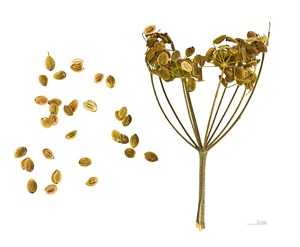
|
Pastinaca sativa |
https://en.wikipedia.org/wiki/Parsnip
true
Moist
Full sun, Partial sun/shade
4-8
Wild parsnip
Light (sandy), Medium, Heavy (clay)
Apiaceae or umbelliferae
1.0
Pastinake
Roots
Leaves, Root, Seed, Shoots
Weed potential
Biennial
https://pfaf.org/User/Plant.aspx?LatinName=Pastinaca sativa
Sicilia
Albania, Altay, Austria, Baltic States, Belarus, Belgium, Bulgaria, Central European Rus, Corse, Czechoslovakia, East European Russia, France, Germany, Great Britain, Greece, Hungary, Italy, Krasnoyarsk, Krym, Lebanon-Syria, Mongolia, Netherlands, North Caucasus, Poland, Romania, Sardegna, South European Russi, Spain, Switzerland, Transcaucasus, Turkey, Turkey-in-Europe, Ukraine, West Siberia, Yugoslavia
https://powo.science.kew.org/taxon/urn:lsid:ipni.org:names:845768-1
0.4
Condiment
Pest control
|
Show
Edit |
|
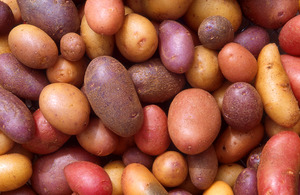
|
Potato |
3-10
Full sun
Moist
Light (sandy), Medium, Heavy (clay)
1.0
0.5
Perennial
12 inches
Seed - direct sow
April
Root
Irish potato, Andigena
Kartoffel
Solanaceae
Argentina Northwest, Argentina South, Bolivia, Chile Central, Chile North, Chile South, Colombia, Ecuador, Peru, Venezuela
Assam, Bangladesh, Belgium, Dominican Republic, East European Russia, East Himalaya, France, Great Britain, Haiti, Hawaii, Illinois, India, Ireland, Laos, Maryland, Minnesota, New York, South European Russi, Tadzhikistan, Uzbekistan, Vietnam, Zaïre
https://en.wikipedia.org/wiki/Potato
https://pfaf.org/User/Plant.aspx?LatinName=Solanum tuberosum
https://powo.science.kew.org/taxon/urn:lsid:ipni.org:names:821337-1
Rutin
Alcohol, Biomass, Cleanser, Cosmetic, Polish, Starch
true
|
Potato (Solanum tuberosum) is a herbaceous perennial plant that is native to the Andean region of South America. It is a member of the nightshade family (Solanaceae) and is closely related to other nightshades such as tomatoes, eggplants, and bell peppers. The potato plant has a bushy growth habit and can grow to heights of 30-150 cm depending on the variety. The leaves are large, heart-shaped, and alternate along the stem. The flowers are white or purple and have five petals. The plant produces small green berries that contain numerous seeds, but most varieties of potatoes are propagated vegetatively from tubers rather than from seeds. The edible part of the potato plant is the tuber, which is an underground stem that is modified for food storage. Potatoes come in a wide range of shapes, sizes, and colors including white, yellow, red, and purple. The size and shape of the tuber depends on the variety, with some varieties producing small, round tubers and others producing large, elongated tubers. Potatoes grow best in well-draining, fertile soils in a sunny location with a pH of 4.5-6.0. They require regular watering and should be planted in a location with good air circulation to prevent fungal diseases. Potatoes are typically planted from tubers that have been treated with a fungicide to prevent disease and are spaced 25-30 cm apart in rows that are 75-90 cm apart. The tubers will begin to form in the soil around 6-8 weeks after planting and can be harvested when they reach the desired size. Potatoes are a versatile and nutritious food source that is rich in vitamins, minerals, and fiber. The tubers are eaten cooked, baked, fried, or mashed, and the leaves and flowers of the plant can also be eaten. Potatoes can be stored in a cool, dry, and dark place for several months. Potatoes have a number of uses beyond their value as a food source. The tubers can be used as seed potatoes for planting, and the leaves and stems can be used as a natural insecticide or as mulch in the garden. In some parts of the world, potatoes are also used for their medicinal properties. Potatoes are a valuable food source for a variety of wildlife, including deer, rabbits, and squirrels. The flowers of the potato plant are also a source of nectar for bees and other pollinators. |
Show
Edit |
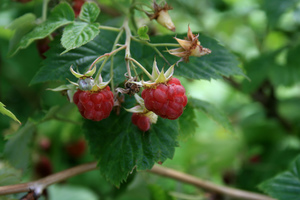
|
Red raspberry |
3-8
Perennial
Full sun, Partial sun/shade
Moist
Light (sandy), Medium, Heavy (clay)
Deciduous
2.0
Shrubs
Cosmetic, Dye, textiles
true
Fruit, Root, Shoots, Stem
https://en.wikipedia.org/wiki/Rubus_idaeus
Medium
American red raspberry, Grayleaf red raspberry
Rosaceae
Himbeere
https://pfaf.org/User/Plant.aspx?LatinName=Rubus idaeus
Framboos
Hindbær
Alaska, Albania, Altay, Amur, Arizona, Austria, Baltic States, Belarus, Belgium, British Columbia, Bulgaria, Buryatiya, California, Central European Rus, China North-Central, China South-Central, Chita, Colorado, Connecticut, Corse, Czechoslovakia, Delaware, Denmark, District of Columbia, East European Russia, Finland, France, Germany, Great Britain, Greece, Hungary, Idaho, Illinois, Indiana, Iowa, Ireland, Irkutsk, Italy, Japan, Kazakhstan, Khabarovsk, Kirgizstan, Korea, Krasnoyarsk, Krym, Labrador, Magadan, Maine, Manchuria, Manitoba, Maryland, Massachusetts, Mexico Gulf, Mexico Northeast, Mexico Northwest, Michigan, Minnesota, Missouri, Mongolia, Montana, Nebraska, Netherlands, Nevada, New Brunswick, New Hampshire, New Jersey, New Mexico, New York, Newfoundland, North Carolina, North Caucasus, North Dakota, North European Russi, Northwest European R, Northwest Territorie, Norway, Nova Scotia, Nunavut, Ohio, Oklahoma, Ontario, Oregon, Pennsylvania, Poland, Primorye, Prince Edward I., Qinghai, Québec, Rhode I., Romania, Sakhalin, Saskatchewan, Sicilia, South Dakota, South European Russi, Spain, Sweden, Switzerland, Tennessee, Transcaucasus, Turkey, Turkey-in-Europe, Turkmenistan, Tuva, Ukraine, Utah, Vermont, Virginia, Washington, West Siberia, West Virginia, Wisconsin, Wyoming, Xinjiang, Yakutskiya, Yugoslavia, Yukon
Arkansas, Falkland Is., Iceland, Mexico Central, Mexico Southwest, Mississippi, New Zealand North, New Zealand South, Tadzhikistan, Uzbekistan, Victoria
1.5
https://powo.science.kew.org/taxon/urn:lsid:ipni.org:names:298089-2
Coffee, Tea
|
Raspberry (Rubus idaeus) is a plant native to Europe, Asia, and North America. It is a perennial plant that grows upright with canes that can reach up to 5 feet in height. The leaves are green and compound, with 3-5 leaflets on each stem. The flowers are white or pink and have five petals. The fruit of the raspberry plant is a red, edible drupe that is about the size of a small marble. Raspberry plants prefer well-drained soil and full sun, but they can also tolerate partial shade. To cultivate raspberries successfully, a grower may need to provide support for the canes, as well as prune them regularly to promote new growth. Raspberries are typically propagated through root cuttings or by dividing the root system. Raspberries are edible and the fruit can be eaten fresh or used in a variety of dishes. The fruit can also be frozen or canned for later use. In addition to their use as a food, raspberries have been used medicinally for their astringent and anti-inflammatory properties. The leaves of the raspberry plant can also be brewed into a tea. Raspberry plants are valued for their fruit, but they also provide habitat and food for a variety of wildlife, including birds and small mammals. The plants can be used as a natural form of pest control, as they attract beneficial insects that prey on pest insects. |
Show
Edit |

|
Sage |
3-11
Annual, Perennial
Full sun
Dry, Moist
Light (sandy), Medium
Evergreen
0.6
Herbs
Flowers, Leaves
https://en.wikipedia.org/wiki/Salvia_officinalis
Medium
Kitchen sage, Small Leaf Sage, Garden Sage, Adacayi, Broadleaf sage, Ching-chieh, Common sage, Echter salbei, Mariyamiya, Sa er wei ya, Salbei, Salie, Salva, Salvia, Sauge commune, Sauge officinale, Sauge, Shalfey, True sage
Lamiaceae or Labiatae
Salbei
https://pfaf.org/User/Plant.aspx?LatinName=Salvia officinalis
Albania, France, Germany, Greece, Italy, Spain, Switzerland, Yugoslavia
Alabama, Algeria, Austria, Azores, Baleares, Bulgaria, California, Canary Is., Connecticut, Czechoslovakia, Georgia, Idaho, Kentucky, Korea, Libya, Maine, Maryland, Michigan, Morocco, New York, Ohio, Ontario, Oregon, Pennsylvania, Portugal, Québec, Rhode I., Romania, Sardegna, Sicilia, South European Russi, Tennessee, Transcaucasus, Tunisia, Turkey-in-Europe, Ukraine, Uruguay, Utah, Vermont, Virginia, Washington, West Virginia
0.75
https://powo.science.kew.org/taxon/urn:lsid:ipni.org:names:456833-1
Condiment, Tea
Compost, Essential Oil, Strewing, Teeth, Dynamic accumulator, Ground cover, Fragrance
true
|
Sage is a perennial herb native to the Mediterranean region. It has woody stems with gray-green leaves that are typically 2-4 inches long and have a soft, velvety texture. The flowers of sage are small and typically blue or purple, although they can also be white or pink. Sage grows to a height of about 2-3 feet and has a spreading habit. Sage prefers well-drained, sandy soil and full sun, and is drought-tolerant once established. It is winter hardy in most climates, but may need to be protected in very cold regions. To cultivate sage successfully, it is important to prune the plant regularly to promote new growth and prevent the plant from becoming woody. The leaves of sage are edible and have a strong, savory flavor. They can be used fresh or dried and are often used in dishes such as stuffings, sausages, and marinades. The leaves can also be stored for later use by drying them and storing them in an airtight container. Sage has a number of uses beyond its culinary value. It has traditionally been used for its medicinal properties, and is said to have antibacterial and anti-inflammatory effects. It is also often used as a fertility herb and is said to promote lactation in nursing mothers. Sage can also be used as a natural insect repellent and as a mulch to suppress weeds. Sage is valued by wildlife for its nectar, which attracts bees and other pollinators. It is also an important host plant for the larvae of several species of butterflies and moths. In addition, the leaves of sage can be used as a natural insecticide to control aphids and other garden pests. In humid zones above 9 it might be only possible to grow as an annual. |
Show
Edit |

|
Cauliflower |
3-10
Full sun, Partial sun/shade
Moist
Light (sandy), Medium, Heavy (clay)
0.8
Annual, Biennial
3-7 years
Companion, antifungal, Dynamic accumulator
true
Flowers, Leaves
Blumenkohl
Brassicaceae or cruciferae
https://pfaf.org/User/Plant.aspx?LatinName=Brassica oleracea botrytis
|
Annual plant reproduced by seed. |
Show
Edit |
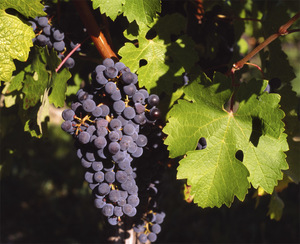
|
Common Grape Vine |
6-10
Perennial
Full sun, Partial sun/shade
Dry, Moist
Light (sandy), Medium, Heavy (clay)
Deciduous
15-32m
Vines
True
Flowers, Fruit, Leaves, Seed
Seed - direct sow, Cuttings
https://en.wikipedia.org/wiki/Vitis_vinifera
Fast
Wine grape, Purpleleaf grape, Common grape, Angur, Diva loza, Grozde yagorida, Tumpeang ba'y chu, Uva, Vid, Vigne, Vino, Weinrebe, Aanab, Ainab, Aitoviiniköynnös, Lehti, Angoor, Angur, Blad från vinranka, Bortermo szolo levél, Cognac oil, Common grape vine, Dakh, Darakh, Drakh, Draksa, Draksh, Draksha, Draksha kottai, Draksha pondu, Drakshai, Drakya, Dry grapes, Drak?a (fruit), European grape, Feuille de vigne rouge, Folha de videira, Frunze de vita-de-vie, Gostani, Gostoni, Grape, Grape seeds oligomeric proanthocyanidins, Grape vine, Grapevine, Grapevine leaf, Kashmish, Kishmish, Kottai drakshai, Lambrusca, Lambrusque, Lie de vin, List vinica, List vinske trte, Lisc winorosli wlasciwej, Maneka, Maweez munaqqa, Maweezak kohi, Munaca, Munaqqa, Munkka, Munthringya, M?dvika, Parra, Raisins, Rote weinrebenblätter, Rød vinranke, Blad, Tikruju vynmedžiu lapai, Vid, Hoja de, Vigne, Vigne rouge, Vigne vinifère, Viinapuu lehed, Vinblad, Vine, Vinho, Vino, Vite, Foglia, Vitis vinifera, Flos, Vitis viniferae folium, Vínviðarlauf, Weinrebe, Werqa tad-dielja, Wijnstokblad, Wine, Wine grape, Zabeeb-ul-jabal, Cervený list vinné révy, Ista vinkoka lapas
Vitaceae
Weintraube
Oil
https://pfaf.org/user/plant.aspx?latinname=Vitis+Vinifera
Southern Europe, Central Europe, Southwestern asia , Albania, Austria, Bulgaria, Corse, Cyprus, Czechoslovakia, France, Germany, Greece, Hungary, Iran, Iraq, Italy, Kirgizstan, Krym, Lebanon-Syria, North Caucasus, Palestine, Romania, Sardegna, Sicilia, Switzerland, Tadzhikistan, Transcaucasus, Turkey, Turkey-in-Europe, Turkmenistan, Ukraine, Uzbekistan, Yugoslavia
4.3-8.6
Tap
0.6-6m
8feet
6 weeks
20°c (69°f)
12 months
False
Druif
Vindrue
Afghanistan, Algeria, Angola, Argentina Northeast, Azores, Baleares, Bangladesh, Belgium, British Columbia, California, Canary Is., Cape Verde, Caroline Is., Chad, China North-Central, China South-Central, China Southeast, East Aegean Is., East European Russia, East Himalaya, Easter Is., Ecuador, Eritrea, Ethiopia, Gulf of Guinea Is., Idaho, India, Kazakhstan, Korea, Kriti, Laos, Libya, Madeira, Massachusetts, Morocco, New Hampshire, New York, New Zealand North, Oregon, Pakistan, Pennsylvania, Peru, Poland, Portugal, South European Russi, Spain, Tibet, Trinidad-Tobago, Tunisia, Vietnam, Washington, West Himalaya
https://powo.science.kew.org/taxon/urn:lsid:ipni.org:names:30478388-2
1
|
This is the common grape which has a lot of varieties but only a few are grown (commercially). Common Grape Vine (Vitis vinifera) is a species of grapevine native to the Mediterranean region, central Europe, and southwestern Asia. It is a woody perennial vine that grows to a length of 20-30 feet when supported by a trellis or other structure. The leaves are dark green and palmately lobed, with five to nine leaflets. The flowers are small and greenish-white, and are produced in clusters. The fruit is a berry, typically blue or purple in color, and is edible. In terms of growth and cultivation, Common Grape Vine prefers full sun and well-draining soil. It can be grown from cuttings or from grape seeds, and should be trained to a trellis or other support structure. In order to produce fruit, the plant must be cross-pollinated with another grapevine of a different variety. The fruit is typically harvested in the late summer or early fall. The edible fruit of the Common Grape Vine can be eaten fresh or used to make wine, juice, and other products. The fruit can be stored by freezing or canning. The leaves can also be eaten, and are commonly used in dishes such as dolma. In addition to its edible fruit, the Common Grape Vine has several other uses. The leaves can be used as a source of natural dye, and the wood can be used for fuel or to make furniture and other items. The plant also provides habitat and food for a variety of wildlife, including birds and small mammals. Fruits are used to be eaten fresh or used for producing juice, wine or vinegar. Raisins are made out of dried grapes. Leaves and flowers can be eaten too. Seeds are used to produce oil. # Propagation While propagation from seed is possible, propagating from cuttings or grafting is way more common and simple. |
Show
Edit |
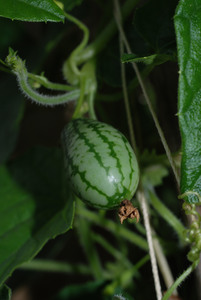
|
Cucamelon |
Annual
Full sun
Vines
Seed - direct sow, Seed - transplant
1 week after last frost
https://en.wikipedia.org/wiki/Melothria_scabra
Cucamelon, Mexikanische mini-gurke
60-70
23cm, 60cm
6.5-7.0
15-30°c (60-85°f)
Mouse melon
Cucurbitaceae
-3
67
Colombia, El Salvador, Guatemala, Honduras, Mexico Central, Mexico Northeast, Mexico Northwest, Mexico Southeast, Mexico Southwest, Nicaragua, Panamá, Venezuela
3-4 weeks before last frost
At last frost
https://powo.science.kew.org/taxon/urn:lsid:ipni.org:names:293320-1
|
Corn, Sunflowers and any other high growing plant, can act as a trellis. #### Propagation Direct sow when soil temperatures reach 15°C (60°F). Plant inside 3-4 weeks before planting outside, and use bottom-heat to help germination. Transplant when plant develop their third true leaf. #### Links [Cucamelon @ West Coast Seeds](https://www.westcoastseeds.com/products/cucamelon) |
Show
Edit |

|
Papalo Quelite |
Leaves
antifungal
Herbs
10-11
Annual
Full sun, Partial sun/shade
Dry, Moist
Light (sandy), Medium, Heavy (clay)
5 feet
http://tropical.theferns.info/viewtropical.php?id=Porophyllum+ruderale
Asteraceae
Yerba Porosa, Quilquina, Bolivian Coriander, Papalo, Killi, Summer Cilantro
antiinflammatory; roots as pain relief from rheumatism and erysipelas
21°C (70°F)
7-21 days
Seed - direct sow, Seed - transplant
May and later
seed indoors and plant outside when 6 inch tall
Argentina Northeast, Argentina Northwest, Arizona, Aruba, Bahamas, Bolivia, Brazil North, Brazil Northeast, Brazil South, Brazil Southeast, Brazil West-Central, Cayman Is., Chile North, Colombia, Costa Rica, Cuba, Dominican Republic, Ecuador, El Salvador, French Guiana, Galápagos, Guatemala, Guyana, Haiti, Honduras, Jamaica, Leeward Is., Mexico Central, Mexico Gulf, Mexico Northeast, Mexico Northwest, Mexico Southeast, Mexico Southwest, Netherlands Antilles, New Mexico, Nicaragua, Panamá, Paraguay, Peru, Puerto Rico, Suriname, Texas, Trinidad-Tobago, Uruguay, Venezuela, Venezuelan Antilles, Windward Is.
China Southeast, Ivory Coast, Jawa, Lesser Sunda Is., Malaya, New Guinea, Queensland, Réunion
https://powo.science.kew.org/taxon/urn:lsid:ipni.org:names:208446-2
|
An annual native to Mexico through South America. Leaves are strongly aromatic and can be used as a seasoning. |
Show
Edit |